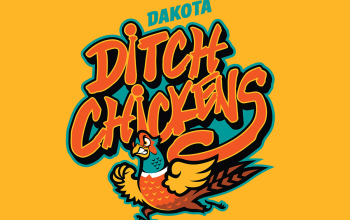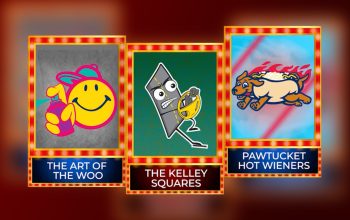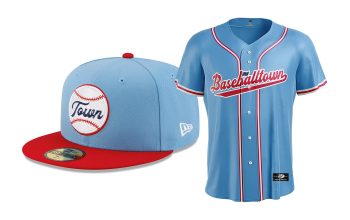It’s a safe guess that the Lowell Spinners, a short-season class-A Red Sox affiliate in the New York-Penn League, are the only sports team whose identity is based on yarn.
 In the early 1800s, the city of Lowell, Massachusetts, rose to prominence as the cradle of the Industrial Revolution. The foundation of the thriving city was water-powered textile mills, which took raw cotton and turned it into cloth or yarn. The main innovation of Lowell’s mills, invented by the town’s namesake, Francis Cabot Lowell, was integrating machines and human employees in one building for the first time. With new technology powered by the nearby Merrimack River and operated at first by the “Lowell Mill Girls” and later by Irish immigrants, the city was transformed from a farming community to one of the most important in the New World.
In the early 1800s, the city of Lowell, Massachusetts, rose to prominence as the cradle of the Industrial Revolution. The foundation of the thriving city was water-powered textile mills, which took raw cotton and turned it into cloth or yarn. The main innovation of Lowell’s mills, invented by the town’s namesake, Francis Cabot Lowell, was integrating machines and human employees in one building for the first time. With new technology powered by the nearby Merrimack River and operated at first by the “Lowell Mill Girls” and later by Irish immigrants, the city was transformed from a farming community to one of the most important in the New World.
With cotton production eventually moving to Southern states, Lowell fell into decline in the early 1900s and was fairly depressed until a slow rebound began in the 1970s. While the city found a new identity as a trendy destination for arts and culture, many mills were converted to apartments or office buildings. One of the innovations that has contributed to the city’s rebirth was a new minor league baseball stadium, Edward E. LeLacheur Park, which opened in 1996 in the shadow of Lawrence Mills, now a residential building, just over half a mile from Lowell National Historical Park.
The ballpark plays host to the short-season class-A Lowell Spinners, named for the process of cotton spinning.
“If you come to Lowell,” said Spinners Assistant General Manager Jon Boswell, “when you’re at the ballpark, when you’re sitting in the seats in the stands, you look out and you see the smokestacks, you see the old mill buildings, and that’s really where the name the Spinners comes from.”

 The Spinners’ logos, created by Single Source Marketing, feature the product most commonly associated with the mills. “When you look at the logo, you see the yarn, you see thread, you see the spindle,” Boswell said. “And that’s really what we wanted to encompass when we came up with the logo.”
The Spinners’ logos, created by Single Source Marketing, feature the product most commonly associated with the mills. “When you look at the logo, you see the yarn, you see thread, you see the spindle,” Boswell said. “And that’s really what we wanted to encompass when we came up with the logo.”
The team’s most commonly used marks are the primary wordmark with a baseball bat spindle as the letter I and a cap logo that features the spindle with the yarn form the letter S for Spinners, all of this in colors that are almost (but not exactly) those of the only parent club the team has known, the Red Sox.
The Spinners logos might seem understated now, but they’ve been through their fair share of cartoony, kid-friendly logos. In 2004, they had a cap logo that featured their mascot, Canaligator, who comes from Lowell’s power canals (the largest such system in the US).
“The idea was that it would be more appealing to kids,” Boswell said, “and we quickly found out that that was true, but it wasn’t really appealing to any adults.”
 The team moved away from the Canaligator on the cap and focused more on their dizzy baseball named Stitch, who was featured prominenty from the team’s inception in 1996 until the current rebrand in 2008. But Stitch, too, didn’t quite fit the bill, as it were.
The team moved away from the Canaligator on the cap and focused more on their dizzy baseball named Stitch, who was featured prominenty from the team’s inception in 1996 until the current rebrand in 2008. But Stitch, too, didn’t quite fit the bill, as it were.
“He always had a little bit of aggression in his face there,” Boswell said. “When we were sitting down for the logo rebrand, as we got talking, and as we got to spitballing, Stitch kind of became, ‘Is it family friendly?’ We pride ourselves on family as one of the first things we do, and when you see this angry baseball, does that really fit that message?”
While the wordmark and the S cap that the Spinners use are more serious than the Canaligator and Stitch, the Spinners do still have some cartoon characters among their lesser-used alternate logos, which include a yarn guy on a spindle (“To be honest, I can’t think of how we’ve utilized him at all since we’ve created him,” Boswell said), a ball of yarn on a spindle that the team uses only as a sleeve patch, and a Stitch descendant clutching a Red Sox-style L, which is only used on retail items.
While the Spinners have a distinct identity and a deep back story, the team is aware that it’s competing for kids’ attention in an increasingly crowded minor league marketplace. They participate in the Little League uniform program, but how could they get kids interested in a logo based on the Industrial Revolution and buildings that have been around for 200 years?
“You look around, Boswell said, “and you see all these funny team names like the Biscuits and the Rubber Ducks and those are the ones that all the Little League teams are named, even in your local community, and we were like, ‘How do we change that?’”
By playing on your community’s hate for their biggest rival, that’s how. The Spinners play just 25 miles from Boston, so their fans are likely to have specific feelings about a certain team to the south. Thus was born the Yankees Elimination Project, which not only did away with a lot of Little League Yankee gear, but was a great way to promote the Spinners.
“If your Little League team in the market was named the Yankees, we would allow you to become the Spinners,” Boswell said. “We would provide hats and a stipend to get T-shirts or jerseys or whatever the league happened to make. We had kids who would say, ‘I don’t want to be a Yankee,’ so we didn’t want anyone to have to be a Yankee either.”
The Spinners have an understated logo based on a serious aspect of their community’s past, and they play at the lowest level of the affiliated minor leagues, so you’re not likely to see them topping any merchandise sales charts. But they are beloved by the local community and have a loyal fan base—the team sold out 413 straight games from 1999 to 2010. The Spinners accomplish exactly what they hope to with their identity. What they lack in pizzazz (what I think of as “the Chihuahua effect”) they make up for in consistency and sincerity, maintaining the same name for two decades and relying heavily on just a couple logos for most of their branding.

















